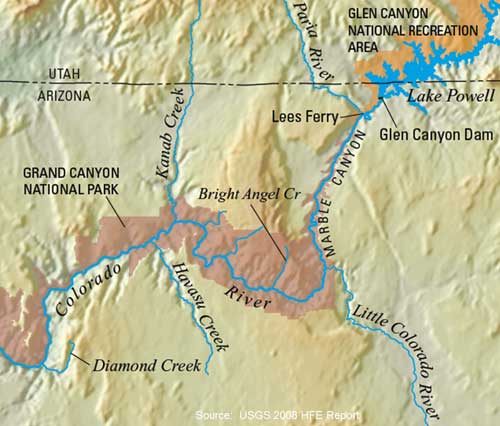|
DAY 1
The Colorado River was first noted in written records in 1539 by Spanish explorers. It was given the name Rio del Tizon (River of Embers) based on a practice used by the natives for warming themselves. Maps from the 17th through early 19th centuries reveal a wide variety of names being applied to the Colorado and its tributaries, including Grand River. In 1921, its current name became official.
The Colorado River (meaning Red River in Spanish) doesn't look very red today. The red basically disappeared upon completion of the Glen Canyon Dam in 1963, which trapped all the silt and sediments that gave it its color.
The river's source is La Poudre Pass Lake, located at over 9,000 feet in Rocky Mountain National Park, just west of the Continental Divide. From there it flows through Grand Lake (the largest natural body of water in Colorado) and Lake Granby. It meets the Roaring Fork River at Glenwood Springs and the Gunnison River in Grand Junction. It crosses Utah through Moab, Dead Horse Point State Park and Canyonlands National Park where it is met by the Green River. The Colorado then flows into Lake Powell, which is formed by the Glen Canyon Dam. Below the dam, water released from the bottom of the lake makes the river clear and very, VERY cold.
At Lees Ferry (elevation 3,110 feet), it begins its course through Marble Canyon. At the southern end of the canyon, it is joined by the Little Colorado River. It then turns abruptly west through the Grand Canyon. The river will drop another 2,200 feet before it reaches the other end of the Grand Canyon 277 miles away. The river's depth ranges from 6 - 100 feet, with the average being about 20 feet. It contains alternating sections of rapids (shallow sections) and calm sections (the deepest parts). The rapids represent only 10% of the river's total length through the Grand Canyon but are responsible for more than half of the total drop in altitude. At Hoover Dam, the Colorado forms Lake Mead, then flows south to end its journey to the Gulf of California.

Map of the Colorado River through the Grand Canyon, with various rafting stops and rapids. Click for a larger version.

Other rivers flow into the Colorado River. Click for a larger version.
At noon on Sunday, a truck from PRO (Professional River Outfitters, Inc.) arrived at our hotel in Flagstaff (Arizona) and we loaded up our personal gear. We left our cars at the hotel and set off in a van toward the North Rim. Scattered showers fell as we drove through a landscape filled with horses, cows, sheep, junipers and pinyon pines. Eventually we arrived at Lee's Ferry.
Lee's Ferry is the former location of a ferry established in 1871 by John D. Lee, a Mormon settler. It was originally named Paria Crossing due to its close proximity to the confluence of the Paria River with the Colorado River. The ferry was closed in 1928 when Navajo Bridge was built about 4 miles away. Today the site is used primarily for fishing and launching rafts.

Loading up the truck

We unloaded the truck and began to set up the rafts amid a mild level of chaos. First we were given one command from one person, then a contradictory one from someone else. But eventually progress was made. Most of the gear (such as the rafts, oars, food, containers, etc) was provided by the outfitting company.


The beer necessities

Setting up on the banks of the Colorado River

Inflating the rafts

Reviewing knots
There was a wide range of experience levels. I, for example, had only been rafting once before, for a half-day trip in Colorado; a few had years of experience under their belts and had done the Grand Canyon numerous times; others had lots of rafting experience but this was their first time doing the Grand Canyon.

Organizing the ammo cans
Ammo cans are water-tight metal boxes used by the military to store different-sized ammunition. In rafting, the 50mm cans were used as small personal boxes while the larger 20mm cans (or rocket boxes) were used for group supplies such as food and gear.

Progress is being made.

The cargo is loaded in the drop box.
Once the rafts were prepared and loaded, we floated about 500 feet downstream to a campsite for the night.

Life jackets are the law when on the Colorado River.
We unloaded our gear and began setting up the tents. Dinner was supposed to be on the beach so we could learn the cooking set up. But somehow plans got changed and we ended up suddenly heading off to the Marble Canyon restaurant instead, before our tents were even finished being set up. During our meal, we were given more detailed instructions about the various rafting chores and assignments.
When we returned to camp, I discovered my snack bag had been torn apart and raided by birds or mice. Such is the price for having been hurried away so suddenly. We finished setting up the tent in the dark then listened to the nearby generators and our loud champagne-drinking neighbors.
return • continue
|
|

